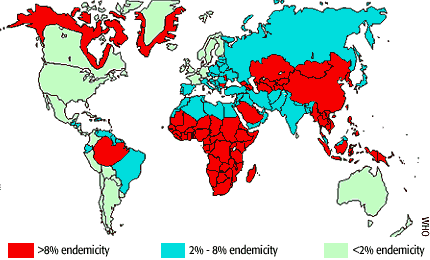 |
|
|
Immunization Focus - the GAVI quarterly |
||||
|
GRASSROOTS - March 2001 En Français Introducing hepatitis B vaccine As the first round of countries prepare to immunize children for the first time against hepatitis B, Scott Wittet shares some tips in advocacy, communication, and training from developing countries that have done it already HEPATITIS B is a killer, taking the lives of 900,000 people each year. Chronic carriers of the virus can infect others and are at risk of developing serious liver disease later in life, including cancer. Fortunately, hepatitis B vaccine can prevent infection and the World Health Organization recommends that all children worldwide should receive it.
The vaccine has been available for decades, but many countries still cannot afford to use it. The partners of GAVI and the Vaccine Fund are working to change this situation. PATH (the Program for Appropriate Technology in Health) worked on some of the earliest introduction programmes for hepatitis B vaccine in Asia and Africa, under the aegis of the International Task Force on Hepatitis B Immunization. Here, we share some lessons we learned over a decade about effective advocacy with decision-makers, communication with parents and caretakers, and the training of health staff regarding hepatitis B. As with the introduction of any new vaccine, there are some general rules. Plan your strategies for communication and training ahead of time. Use research to investigate providers' and consumers' knowledge and behaviour – these data can guide the design of messages and information products. Coordinate with colleagues in all parts of the health care system that will be affected, and make sure that messages and materials for key audiences are consistent. Finally, parents report that their most reliable source of information about immunization is their health care provider, so it is important that providers be able to accurately explain hepatitis B, the vaccine, and the importance of immunizing children. Focus on improving communication between providers and consumers first, and then use other media to support those interpersonal efforts. Here are some specific suggestions: 1. Overcome confusion among decision-makers, providers, and the public Hepatitis, and hepatitis B immunization, are confusing subjects for both providers and parents. Here are some common sources of confusion:
2. Use every opportunity to educate providers about hepatitis B How you can do this most effectively depends on your situation, as the following examples show:
3. Design materials based on audience needs
4. Don't waste resources on unnecessary materials Evaluations in Indonesia and Thailand showed that mass distribution of expensive printed materials for parents was not cost-effective.
Hope for the future In the decade since the first Task Force programmes, many countries have found ways to integrate hepatitis B immunization into their national programmes. Botswana, China, Egypt, Indonesia, The Philippines, South Africa, Thailand, Tunisia, and Zimbabwe are among the developing world nations that now routinely protect their children against hepatitis B. With assistance from the GAVI partner agencies and the Vaccine Fund, more than 30 additional countries are beginning introductory efforts. There is one additional, and crucially important, opportunity that the GAVI partners must not let slip away: now is the time to give the "polio troops" a new mission in countries where National Immunization Days are phasing out. No one has been more successful than the Polio Eradication Initiative in mobilizing communities for health. Now that polio eradication efforts are winding down in many areas, staff and volunteers can broaden their efforts, focusing on improving routine immunization and other primary health care programmes. Scott Wittet is Director for Advocacy, Communication, and Training at the Bill and Melinda Gates Children's Vaccine Program at PATH. For more information about hepatitis B and immunization programmes, visit the Resource Center of the Bill and Melinda Gates Children's Vaccine Program at PATH website, http://www.ChildrensVaccine.org or contact the GAVI Secretariat c/o UNICEF, Palais des Nations, 1211 Geneva 10, Switzerland. Email: gavi@unicef.org This is an edited version of a paper presented at the GAVI Partners' Meeting in Noordwijk, the Netherlands in November 2000. The full paper can be downloaded from http://www.childrensvaccine.org/html/ip_advocacy.htm Immunization Focus March 2001 - Contents |
||||
|
|
|
Copyright © GAVI |

